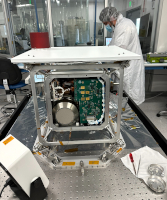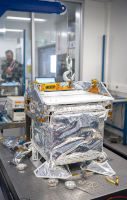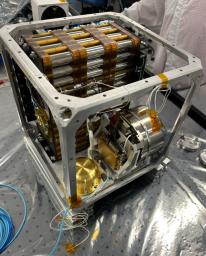NASA's Farside Seismic Suite (FSS) is assembled in a clean room at the agency's Jet Propulsion Laboratory in Southern California in November 2023. Two sensitive seismometers packaged in the suite's cube-within-a-cube structure will gather NASA's first seismic data from the Moon in nearly 50 years and take the first-ever seismic measurements from the Moon's far side. FSS will operate continuously for at least 4½ months, working through the long, cold lunar nights.
Seen here is the inner cube structure, with the suite's large battery at rear. The gold, puck-shaped device at left is the Short Period sensor, or SP, which measures motion in three directions using sensors etched into a trio of square silicon chips, each about 1 inch (25 millimeters) wide. At right, within the silver cylindrical enclosure, is the Very Broadband seismometer, or VBB, the most sensitive seismometer ever built for use in space exploration. It can detect ground motions smaller than the size of a single hydrogen atom, measuring up-and-down movement using a pendulum held in place by a spring. Constructed as a backup instrument (a "flight spare") for NASA's InSight Mars lander by the French space agency, CNES (Centre National d'Études Spatiales), the VBB was slightly modified and packaged in a new enclosure for lunar use. The suite's computer and electronics are packed alongside the battery and seismometers.
After being encased in insulation, this inner cube was suspended within a protective outer cube, which was in turn covered with a shiny insulating blanket.

Figure AFigure A, taken in February 2024, shows the completed inner cube – with the VBB at bottom left and electronics filling much of the remaining space – suspended by rods within the outer cube. On top is a white radiator that allows the suite to shed heat generated by its electronics during the hot lunar daytime hours. The red cylinder atop the radiator houses the suite's antenna, for communicating with two small relay satellites that will orbit the Moon and send data to Earth. Insulating layers between the cubes and on the exterior would be added later.

Figure BFigure B, captured in March 2024, shows FSS encased in its shiny exterior insulating blanket. A fixture attached at top allows the payload to be moved in the clean room.
A division of Caltech in Pasadena, California, JPL manages, designed, assembled, and tested Farside Seismic Suite. The French space agency, CNES (Centre National d'Études Spatiales), and IPGP (Institut de Physique du Globe de Paris) provided the suite's Very Broadband seismometer with support from Université Paris Cité and the CNRS (Centre National de la Recherche Scientifique). Imperial College, London and the University of Oxford collaborated to provide the Short Period sensor, managed by Kinemetrics in Pasadena. The University of Michigan provided the flight computer, power electronics, and associated software.
A selection of NASA's PRISM (Payloads and Research Investigations on the Surface of the Moon), FSS is funded by the Exploration Science Strategy and Integration Office within the agency's Science Mission Directorate. The Planetary Missions Program Office at NASA's Marshall Space Flight Center provides program management. FSS will land on the Moon as part of an upcoming lunar delivery under NASA's CLPS (Commercial Lunar Payload Services) initiative.

 Planetary Data System
Planetary Data System














